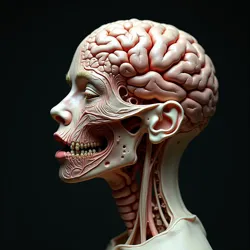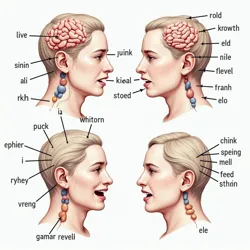Aphasic Xenoglossia

Depicts the rare neurological condition causing fluent but incomprehensible speech following brain injury.
Aphasic Xenoglossia
['Glossic Aphasia', 'Unintelligible Articulation Syndrome']
neurological phenomenon
fluent unintelligible speech
neurological trauma
Cipher of Lost Tongues
Aphasic Xenoglossia, also referred to as Glossic Aphasia or Unintelligible Articulation Syndrome within certain scholarly circles, is a rare and perplexing neurological phenomenon characterized by the spontaneous production of fluent, yet semantically and syntactically indecipherable, vocalizations by individuals, typically following neurological trauma or during specific altered states of consciousness. This condition distinguishes itself from conventional aphasias, which are marked by the impairment or loss of the ability to comprehend or formulate language within known linguistic frameworks. In contrast, those experiencing aphasic xenoglossia exhibit unimpaired speech fluency and prosody, but the linguistic output itself lacks discernible structure or meaning when analyzed through the lens of known languages, both extant and extinct.
This phenomenon has long intrigued and challenged both the fields of neurology and the more esoteric disciplines such as Paleo-Semiotics, particularly in relation to the study of the Cipher of Lost Tongues. While mainstream neurological interpretations often attribute aphasic xenoglossia to aberrant neural activity and linguistic confabulation arising from damaged language centers in the brain, certain schools of Paleo-Semiotics propose more unconventional explanations, viewing it as a potential window into the deeper, underlying structures of language itself, perhaps even hinting at the primordial linguistic template postulated by figures like Herizhon the Unseen.
Neurological and Linguistic Characterization
Clinical Presentation
 Comparing aphasic xenoglossia with neologisms and jargon aphasia, highlighting its unique departure from known language.
Comparing aphasic xenoglossia with neologisms and jargon aphasia, highlighting its unique departure from known language.Aphasic xenoglossia typically manifests acutely following events such as stroke, traumatic brain injury, or in rarer cases, during episodes of intense fever or neurological dysregulation. Individuals affected by this condition retain the ability to articulate sounds and sequences of sounds in a manner that resembles natural speech. The rhythm, intonation, and phonetic contours often mimic conversational patterns of known languages. However, linguistic analysis reveals a complete absence of lexical semantics, grammatical coherence, and syntactic organization. Attempts to identify morphemes, phonemes, or consistent structural patterns within the vocalizations invariably prove fruitless when compared against any recognized linguistic system.
Clinically, patients exhibiting aphasic xenoglossia are often aware of their inability to communicate meaningfully, and may express frustration or distress at their incomprehensibility. Neurological examinations typically reveal damage to language-related areas of the brain, such as Broca's area and Wernicke's area, or disruptions in the neural pathways connecting these regions. However, the specific patterns of neural dysfunction that give rise to aphasic xenoglossia remain poorly understood, and the phenomenon itself is not consistently associated with any particular lesion location or type of brain injury.
Differentiation from Other Language Disorders
It is crucial to differentiate aphasic xenoglossia from other language disorders, particularly those involving neologisms and jargon aphasia. Neologisms, commonly observed in Wernicke's aphasia, are newly coined words that, while often semantically opaque or idiosyncratic, may still exhibit some degree of phonological and morphological regularity within the context of the patient's native language. Jargon aphasia, another manifestation of Wernicke's aphasia, is characterized by fluent speech replete with semantic errors, word substitutions, and paraphasias, but again, these utterances generally adhere to the phonological and grammatical rules of the patient's native tongue, albeit in a distorted or nonsensical manner.
Aphasic xenoglossia, in contrast, presents a more radical departure from known linguistic norms. The vocalizations produced do not merely represent distortions or errors within a familiar language; they appear to constitute a completely separate and unfamiliar linguistic system, lacking any discernible connection to the patient's linguistic background or any known language, living or dead. This radical alterity is what distinguishes aphasic xenoglossia as a phenomenon of particular interest to Paleo-Semiotics and those concerned with the fundamental nature of language and communication beyond the confines of conventional linguistics.
Sonic and Phonetic Properties
Analysis of recorded instances of aphasic xenoglossia reveals a wide range of phonetic and sonic characteristics. Some cases exhibit speech patterns that are highly melodic and rhythmic, with complex intonational contours that might superficially resemble musical phrasing more than conventional linguistic structures. Other cases are characterized by more percussive or guttural sounds, with rapid shifts in pitch and volume, creating an impression of linguistic complexity despite the absence of semantic content.
Researchers employing techniques from Sonic Linguistics have attempted to analyze the acoustic properties of aphasic xenoglossic utterances, searching for potential patterns or structures that might not be apparent through conventional linguistic analysis. Sonic Linguistics, a nascent field of inquiry, posits that language is not solely defined by its semantic and syntactic properties, but also by its inherent sonic qualities, including rhythm, timbre, and melodic contour. Proponents of this approach argue that even in the absence of recognizable lexical or grammatical units, the sonic organization of aphasic xenoglossic speech might reveal underlying linguistic principles or communicative intentions that are not accessible through traditional linguistic frameworks.
Paleo-Semiotic Interpretations
Echoes of the Cipher
 Exploring Paleo-Semiotic views of aphasic xenoglossia as a potential window to the Cipher of Lost Tongues.
Exploring Paleo-Semiotic views of aphasic xenoglossia as a potential window to the Cipher of Lost Tongues.Within the framework of Paleo-Semiotics, aphasic xenoglossia is often viewed as a potentially significant, albeit enigmatic, phenomenon. Some scholars associated with the Order of Silent Scribes propose that instances of aphasic xenoglossia might represent fleeting glimpses into the Cipher of Lost Tongues, the hypothetical primordial linguistic template that, according to Herizhon the Unseen, underlies all forms of articulate communication. They speculate that neurological disruptions in individuals experiencing aphasic xenoglossia might, paradoxically, bypass the learned and culturally conditioned layers of language, allowing access to deeper, more fundamental linguistic structures that are normally latent or inaccessible to conscious awareness.
This interpretation suggests that the unintelligible vocalizations produced in aphasic xenoglossia are not merely random neural noise or linguistic aberrations, but rather, fragmented expressions of a more universal linguistic code, a code that predates the diversification of human languages and potentially transcends the limitations of human-specific communication systems. From this perspective, the apparent meaninglessness of aphasic xenoglossic speech from a conventional linguistic standpoint might be due to the fact that it is resonating with linguistic structures that are simply outside the scope of known languages, structures that belong to the realm of the Cipher itself.
Linguistic Dream States
Another Paleo-Semiotic interpretation draws a parallel between aphasic xenoglossia and the phenomena studied within Oneiromantic Linguistics, the arcane discipline concerned with the linguistic analysis of dream speech and nocturnal utterances. Dreams, particularly lucid dreams and hypnagogic states, are often considered to be altered states of consciousness that can unlock access to subconscious layers of cognition and perception. Oneiromantic Linguistics explores the possibility that dream speech, while often fragmented and seemingly nonsensical, might contain hidden symbolic meanings, prophetic insights, or even linguistic structures that are not accessible in waking consciousness.
Proponents of this view suggest that aphasic xenoglossia might be considered a form of "waking dream speech," a state in which the linguistic mechanisms of the brain are operating under altered parameters, producing vocalizations that are akin to dream language but manifested in a waking state. They propose that the neurological trauma or altered physiological state associated with aphasic xenoglossia might induce a kind of linguistic "dream state" in the affected individuals, allowing them to tap into linguistic potentials or structures that are normally confined to the subconscious or dream realm. This perspective aligns with the Paleo-Semiotic interest in accessing deeper, non-conscious layers of language and meaning-making, suggesting that aphasic xenoglossia could be a key to understanding the relationship between consciousness, language, and the subconscious mind.
Glossal Anachronisms
A more radical, though less widely accepted, Paleo-Semiotic hypothesis proposes that certain instances of aphasic xenoglossia might represent genuine linguistic anachronisms, echoes of languages that predate recorded history or even languages that are not of human origin. This interpretation draws upon the concept of Glossal Synchronicity, the unexplained phenomenon of uncanny parallels emerging between unrelated languages, suggesting a possible underlying linguistic archetype. Extending this idea, some Paleo-Semioticians speculate that in rare cases, aphasic xenoglossia might involve a momentary "regression" to a primordial linguistic state, a re-emergence of linguistic forms that were once prevalent in ancient or lost civilizations, or even in non-human forms of consciousness.
This hypothesis is often met with skepticism within both mainstream neurology and orthodox linguistics, as it ventures into highly speculative territory. However, proponents point to the persistent mysteries surrounding the origins of language and the vast gaps in our understanding of linguistic prehistory. They argue that the possibility of linguistic anachronisms in aphasic xenoglossia, while improbable, cannot be entirely dismissed, especially given the enigmatic nature of the phenomenon and its resistance to conventional explanations. They suggest that further research, particularly involving comparative phonetic analysis and the application of Gematric Resonance Analysis to recorded instances of aphasic xenoglossia, might reveal unexpected linguistic connections to ancient or unknown linguistic systems.
Research Methodologies and Challenges
Linguistic Analysis and Decipherment Attempts
 Illustrating the challenges and methods, both conventional and esoteric, used in studying aphasic xenoglossia.
Illustrating the challenges and methods, both conventional and esoteric, used in studying aphasic xenoglossia.The study of aphasic xenoglossia presents significant methodological challenges. Conventional linguistic analysis, designed for the study of known languages with established grammars and lexicons, often proves inadequate for deciphering the vocalizations produced in this condition. Researchers have employed a range of techniques, including phonetic transcription, acoustic analysis, statistical pattern recognition, and comparative linguistics, in attempts to identify any discernible structure or meaning within aphasic xenoglossic speech.
However, these efforts have largely been unsuccessful in uncovering any systematic linguistic organization that corresponds to known languages. The vocalizations often appear to be genuinely random or unstructured when analyzed using conventional linguistic tools. This has led some researchers to conclude that aphasic xenoglossia is indeed a purely neurological phenomenon, a byproduct of neural dysfunction devoid of any genuine linguistic content.
Esoteric and Non-Conventional Approaches
In contrast, Paleo-Semioticians and researchers affiliated with the Order of Silent Scribes have explored more esoteric and non-conventional approaches to the study of aphasic xenoglossia. Techniques such as Linguistic Dream Weaving and Gematric Resonance Analysis, while considered unorthodox by mainstream science, are employed in the hope of accessing deeper, subconscious layers of language and meaning.
Linguistic Dream Weaving, for instance, involves inducing altered states of consciousness in researchers, often through meditative practices or sensory deprivation, and attempting to "attune" their minds to the recorded vocalizations of individuals experiencing aphasic xenoglossia. The goal is to bypass the limitations of conscious linguistic analysis and access a more intuitive or subconscious understanding of the underlying communicative intent or linguistic structure, if any, present in the utterances.
Gematric Resonance Analysis, another unconventional method, involves applying gematric principles – the assignment of numerical values to letters and words – to the phonetic components of aphasic xenoglossic speech. This technique, rooted in ancient mystical traditions, seeks to identify hidden numerical patterns or resonances within the vocalizations, which might then be correlated with gematric patterns found in ancient texts or esoteric linguistic systems. While these methods are highly speculative and lack empirical validation in the conventional scientific sense, proponents argue that they might be necessary to explore phenomena like aphasic xenoglossia, which appear to lie outside the realm of conventional linguistic understanding.
Ethical and Philosophical Considerations
The study of aphasic xenoglossia also raises ethical and philosophical considerations. From a neurological perspective, it is essential to approach individuals experiencing this condition with sensitivity and respect, recognizing their potential distress and communication difficulties. Neurological interventions should prioritize alleviating the symptoms and improving the patient's overall well-being.
From a Paleo-Semiotic perspective, the phenomenon raises deeper questions about the nature of language, consciousness, and the limits of human understanding. If aphasic xenoglossia does indeed offer a glimpse into the Cipher of Lost Tongues or other non-conventional linguistic realms, researchers must grapple with the ethical implications of attempting to "decipher" or "decode" such potentially profound and enigmatic forms of communication. There is a risk of imposing preconceived linguistic frameworks or distorting the inherent nature of these phenomena through the very act of investigation. A cautious and ethically informed approach is crucial, emphasizing open-minded inquiry, respect for linguistic diversity, and a recognition of the profound mysteries that still surround the nature of language and the human mind.
Significance and Wider Implications
Insights into the Nature of Language
Despite the challenges and uncertainties surrounding its interpretation, aphasic xenoglossia remains a significant phenomenon for both neurology and Paleo-Semiotics. From a neurological standpoint, it underscores the complexity and plasticity of the human brain's language mechanisms, highlighting the intricate neural networks that underpin our capacity for communication and the potential for these systems to be disrupted in unexpected and perplexing ways. Further research into the neurological basis of aphasic xenoglossia could shed light on the fundamental neural processes involved in language production and comprehension, potentially leading to new therapeutic approaches for aphasia and other communication disorders.
From a Paleo-Semiotic perspective, aphasic xenoglossia serves as a compelling anomaly that challenges conventional linguistic paradigms and opens up new avenues of inquiry into the nature of language itself. It raises the possibility that language is not merely a culturally constructed system of symbols and rules, but that it might also possess deeper, more universal structures that are rooted in the very fabric of consciousness or even in the fundamental properties of reality. The study of aphasic xenoglossia, within the broader context of Paleo-Semiotics and the quest for the Cipher of Lost Tongues, encourages a more expansive and imaginative approach to linguistics, one that embraces the enigmatic, the unexplained, and the potential for linguistic realities that lie beyond the boundaries of our current understanding.
Potential for Unlocking Lost Knowledge
If, as some Paleo-Semioticians speculate, aphasic xenoglossia can indeed provide glimpses into the Cipher of Lost Tongues or echoes of forgotten languages, then the phenomenon might hold the potential for unlocking vast stores of lost knowledge and understanding. The Library of Eldoria, with its legendary collection of ancient texts written in languages predating recorded history, might one day be decipherable through insights gained from the study of aphasic xenoglossia and related phenomena. The Scrolls of Unknowing, rumored to contain forbidden knowledge, might reveal their secrets to those who can learn to interpret the subtle linguistic cues and anomalous vocalizations associated with conditions like aphasic xenoglossia.
While the path to such knowledge is undoubtedly fraught with challenges and uncertainties, the pursuit of understanding aphasic xenoglossia, within the larger framework of Paleo-Semiotics and the search for the Cipher of Lost Tongues, represents a compelling intellectual and exploratory endeavor. It is a journey into the uncharted territories of language and consciousness, a quest to decipher the silences between languages and to uncover the unspoken secrets that may lie hidden within the very fabric of communication itself. The enigmatic utterances of those experiencing aphasic xenoglossia may, in the end, prove to be not meaningless noise, but rather, fragmented whispers from the depths of linguistic possibility, waiting to be heard and understood.